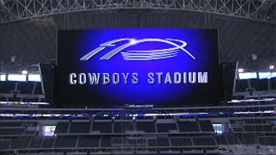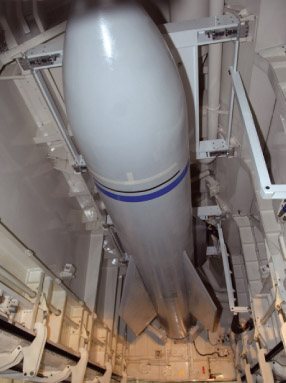October 2009 – Briefings
MASSIVE BOMB + APARTMENTS AFLOAT + PROSTHETIC EYE
Fair Catch?
The video boards of the new Cowboys Stadium in Dallas loom 90 feet above the playing field, well beyond the National Football League’s 85-foot height requirement for hanging objects. So what’s the problem? It’s that they’re so huge. Built by Mitsubishi Diamond Electric, the twin video boards, which project the game and score during play, measure 72 feet high and 160 feet long. And that makes a big target. The Tennessee Titans’ A.J. Trapasso dinged the bottom of one screen during a preseason game. Faced with whether to order that the boards be moved – a 12-hour job – the NFL punted: It ruled that striking a board with a football will result in a replay. But the decision applies only to the 2009 season.
Cell Growth in 3-D
Could skin cells one day be used to cure diabetes? Yes, says Jeffrey R. Morgan, co-director of Brown University’s Center for Biomedical Engineering. Morgan believes that within 10 years, it may be possible to transform a diabetic’s skin cells into blank-slate stem cells that could be turned into the pancreas cells that produce insulin. The engineered cells would be transplanted into a patient’s pancreas, making it healthy again. At present, cells cultured in standard Petri dishes result in two-dimensional tissues that have limited value. But Morgan’s team has developed a three-dimensional Petri dish that can grow clusters of living cells into complex-shaped microtissues, which can be more easily transformed into useful tissue. Morgan’s dishes are made from a gelatinous carbohydrate called agarose, and the cells grown in them don’t stick to their surface but self-assemble into natural-shaped microtissues. Beyond creating organ tissue, Morgan’s 3-D tissue-engineering technology may someday produce tissue samples laced with blood vessels that could be used to test drugs, thereby reducing the need for animals in medical research. –- THOMAS K. GROSE
Ultimate Excavator
As non-nuclear bombs go, nothing would be bigger than the bunker-busting Massive Ordnance Penetrator (MOP) that the U.S. Air Force wants to deploy next year. The USAF is asking Congress for $68 billion to buy four of these mega-bombs from Boeing; ultimately, it wants 16 of them. At 30,000 pounds, the 20-foot-long MOP is so heavy that B-2 or B-52 bombers can carry only one at a time. Some 5,300 pounds of that weight is explosives, making the MOP 10 times as powerful as its predecessor, the BLU-109. It’s also laser guided and can burrow 200 feet into the ground before exploding. North Korea and Iran are both thought to have nuclear bomb-making facilities nestled in deep-earth bunkers. The massive MOP is designed to send a message to both regimes: You can dig, but you can’t hide. – TG
Soak it Up
AUSTRALIA — Ever notice tiny packets of silica gel granules in cardboard boxes containing consumer electronics? Sometimes they carry a warning: “Do Not Eat.” They’re meant to soak up moisture, but Australian engineers have found that these absorbent granules are also useful in reducing harmful gas emissions. Paul Webley (right), associate dean in the chemical engineering department at Melbourne’s Monash University, and his team developed a simple technique for capturing carbon emissions at power stations. Pressurized flue gas is passed through the granules, which absorb carbon dioxide. When the pressure is dropped, “desorption” occurs, allowing the carbon dioxide to be siphoned off for other industrial uses and the absorbent granules to be re-used. The process worked well at a test plant, removing 1.1 tons of carbon dioxide a day. Now Webley’s team is adapting the method to large power stations. Commercial development is expected within five years. – CHRIS PRITCHARD
Engineer to Lead Japan
Japan’s new prime minister, Yukio Hatoyama, shares a distinction with several top Chinese leaders: He’s an engineer. Hatoyama – who recently led the Democratic Party to a stunning defeat of the long-entrenched Liberal Democratic Party – earned his doctorate in managerial engineering from Stanford University in 1976. In the past, he’s criticized America’s “unrestrained market fundamentalism,” and the continued U.S. military presence in Japan. But the Obama administration hopes to win Hatoyama’s cooperation on global warming and North Korea’s nuclear proliferation — both issues for which an engineering background will be helpful. – ROBIN TATU
Villa Flotilla
With 25 percent of the Netherlands already at or below sea level, the Dutch are better prepared than most for the rise in sea levels expected to accompany global warming. One example is the new, aptly named architectural firm, Waterstudio, which specializes in “building in, on, and at the water.” Its design for a water-based development features 1,200 homes. Work begins in March on the site’s centerpiece, the Citadel, a floating luxury apartment complex connected to the mainland by a floating road. Floating buildings have been done before, but Waterstudio is using the latest technologies to take the concept to new levels: 180 modular elements – 60 apartments in all – positioned upon a floating concrete caisson foundation. The Citadel will be energy efficient and make use of green-roof technology. Other Waterstudio projects include stilt houses for flood-prone land and the Watervilla house, whose lowest three stories are partly submerged in water. This innovative young firm should make a splash. – TG
Mind Your Way
An electric-powered wheelchair that users can steer with their thoughts is being developed by Toyota Motor Corp. Monitors fitted into a cap measure brain waves every 125 milliseconds, then send them to an onboard computer. It’s done so rapidly that the time between thought and response is nearly simultaneous, allowing for a more fluid ride than voice-controlled chairs. Users train for three hours a day for a week, which gives the system time to tune itself to their thought patterns. To operate it, users imagine a hand or foot movement, and the chair responds in a corresponding manner, moving right, left, or forward, as well as stopping. As a failsafe, a brake springs into action when a user puffs out a cheek. Toyota’s “Brain Machine Interface” technology is part of Japan’s push to provide better assistance for handicapped and elderly people. The Japanese automaker hasn’t yet announced plans to commercialize the technology, but stay tuned for that next brain wave. – TG
NSF Video: http://www.nsf.gov/news/mmg/mmg_disp.cfm?med_id=65758
Category: Briefings




